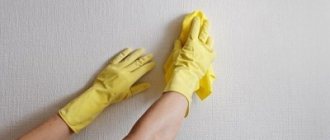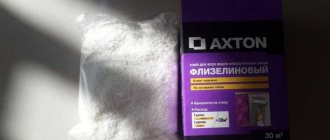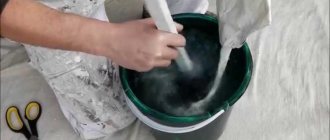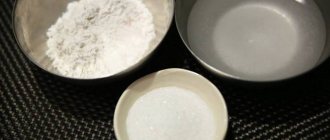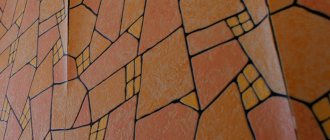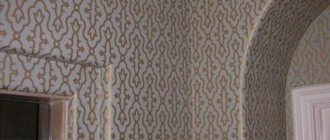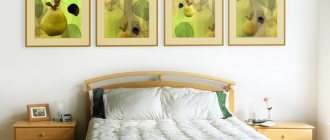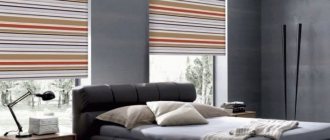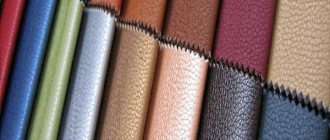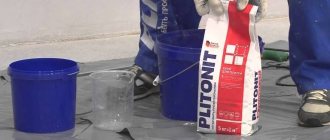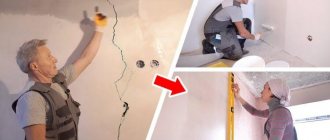Wallpaper innovations
The world's leading factories do not allow themselves to relax; their innovations and new solutions, in a seemingly proven production process, help create new types of materials.
Bright bedroom interior in blue
These newly created finishing materials easily displace old, lower quality and more expensive analogues from the market. To this galaxy of new products we include wallpaper with a foam structure; they can be paper, vinyl, or non-woven.
Due to its excellent decorative properties, ease of gluing, long service life and other equally important advantages, foam wallpaper quickly gained mass popularity among consumers. When compared with numerous analogues, this type of wallpaper has a large number of advantages, and the cost of a roll is not so high.
High quality wallpaper for living room
Some types of wallpaper with a foam structure in neutral colors are actively used not only in residential premises, but also in work premises: offices, change houses, shops.
Where to start gluing foam vinyl wallpaper?
It is best to start gluing from the window. When using large-width tubes, you must first draw a straight vertical line on the wall using a level and place the canvas against the wall, focusing on it. To glue foam vinyl wallpaper, you need to use a soft roller with a small pile, with which you can easily apply the glue to the wall. A wallpaper brush works well to remove air bubbles and can also be used to remove excess glue. The brush movements should be directed from the center of the canvas to the edges. If glue gets on the front side, it must be immediately removed from the surface with a damp cloth.
Foamed vinyl wallpaper should be glued from the ceiling to the shelf and always end-to-end, this will avoid the appearance of bubbles and convex stripes. You cannot start gluing on both sides of the door at once; it is best to move from one side, cutting out the sheets in an L shape, and then apply the next strip. Window niches are glued in the same way, not forgetting to add space under the window. Also, you should not combine two separate canvases in the corners of the walls. In these areas it is better to make a small overlap of a few centimeters in size from the solid tube of wallpaper.
If the wallpaper you choose has a pattern that needs to be selected at the joints, you need to be very careful when cutting the canvases. In such cases, first combine the pattern, and then cut the roll into pieces. As a rule, on each subsequent canvas the ornament shifts by 50 - 100 cm.
As you can see, the procedure for covering walls with vinyl wallpaper is not very complicated and if you have certain skills, you can do it yourself. It is important to remember that when choosing wallpaper and adhesive composition, it is better not to skimp on their quality, since only by using proven materials can you be sure of the final result.
Over the past decades, wallpaper has become a truly popular material. They not only do not go out of fashion, but also expand their presence in the market. This happens, not least, thanks to new products that owe their appearance to the use of the latest technologies in production, as well as an innovative approach to design. Among the most interesting and popular new products among mass buyers are foam wallpaper.
Foam wallpapers have different structures and different bases
Vinyl, paper, non-woven backing and profile - depending on the base raw materials used, as well as production technology, they can be completely different.
Foam wallpapers owe their popularity to the fact that they have a significant number of advantages and disadvantages that make them easier to hang and make their service life longer than many other analogues. Thanks to their attractive appearance, they can significantly decorate the interior of your apartment, making it not only practical, but also individual.
Looks soft and textured
In addition, such canvases will look very organic in a non-residential space, such as an office, cafe or administrative building.
Foam paper wallpaper
Two types of foam wallpaper are created on a paper basis:
- Paper ones, where the foam composition is acrylic foam.
- Vinyl, here the vinyl is foamed, and the paper is the backing.
Paper wallpaper with acrylic foam is distinguished by its bright design and splendor of shapes; in addition, sparkles are mixed into the foam, which shimmer in the sun. However, acrylic foam in most cases does not adhere well to the canvas and is prone to crumbling. Therefore, the use of such wallpaper is not recommended in the hallway or kitchen.
Texture of paper wallpaper with acrylic foam
The range of such paper wallpapers is unique, the design is similar to some representatives of the non-woven world. But we would not recommend gluing this type of wallpaper in high-traffic areas, since they are not very wear-resistant.
Paper acrylic wallpaper produced using the foaming method occupies the lowest price range, but looks quite tolerable.
Embossed wallpaper: characteristics
This type of paper panels for wall decoration contains a relief base, onto which the planned pattern is applied during production. After the initial gluing, the drying time of the canvases is two days. Embossed wallpaper has the property of coloring. After time, you can repaint them the way you like best.
How to glue embossed paper wallpaper?
Before applying embossed wallpaper for painting, it is necessary to level the walls. This will further allow them to stay firmly on the walls for more than 10 years. After plastering the cracks on the wall, you should treat the surface with a primer, this will help prevent the occurrence of mold. As the wall dries, it is sanded with coarse sandpaper. Next, the wall is treated with a finishing primer. The primer solution will allow the strips to set easily and adjust to a butt or overlap size.
Tip: Before the gluing process, you must turn off the electricity.
To avoid drafts, windows in the room should not be open. The room should be warm and dry.
Foamed vinyl wallpaper
Foamed vinyl wallpaper on a paper base is a completely different material - strong, reliable, durable. They are produced by pressing out a stencil.
The vinyl layer is treated at high temperature, after which some substances evaporate from it, and bubbles or pores form in their place. These cavities in solid vinyl make it more airy and thicker, now it can safely be called foam.
Foam wallpaper in the living room interior
We have been using the term “vinyl” for a long time, but have not yet discovered its meaning. Vinyl is nothing more than polyvinyl chloride (PVC) - an artificially created material used for the manufacture of finishing materials: wallpaper, panels, baseboards, corners.
This material allows you to give the wallpaper quality characteristics, for example, hardness and density, which counteract the movement of moisture through it. This counteraction helps prevent the appearance of mold or mildew behind or on the wallpaper.
The finished foam vinyl wallpaper has a soft texture and you can easily feel the embossed pattern on it. Some samples of the same quality may be slightly rough if the relief of the pattern is too great.
Foamed vinyl texture
Among the most popular qualities of such materials, we would like to note the following:
- foamed vinyl perfectly masks defects in the walls on which it is glued, so there is no need to complicate the finishing too much,
- has one of the largest color and stylistic assortments among all wallpapers,
- similar in visual effect to decorative plaster, as it has a noticeable volume visible to the naked eye,
- applicable for all rooms, appropriate both in a large room and in a bedroom.
Recommendations for working with paper-based vinyl
Taking into account the experience of professionals and reviews of DIY repair enthusiasts, we can make a list of important points:
- It is not the wallpaper as such that causes harm, but the increased humidity in the room. To prevent mold from growing on the walls, the room must be regularly ventilated.
- After puttying and priming, the walls dry for at least a day. Wallpaper should only be glued to a completely dry surface.
- Vinyl on any base does not like glue. If the composition gets on the front side of the wallpaper, you need to wipe it off as quickly as possible. When glue stains dry, they leave dark marks on the surface.
- No matter how much glue you need to pour into the water according to the instructions, you need to monitor the thickness of the composition - the glue should not be like water, the wallpaper is made of paper and takes a long time to dry.
- For the bedroom and nursery, it is better to choose calm shades (peach, blue, green, beige); in the kitchen and living room you can play with contrasting textures and colors.
- Materials for repairs should not be too cheap; it is better to choose trusted manufacturers. These are not necessarily foreign factories; in the CIS countries they also make good wallpaper (Slavic, for example).
- No matter how much money is spent on wallpaper, a lot depends on the adhesive composition. You need to choose a special adhesive for a specific type of coating; the manufacturer is also important.
The main function of any wallpaper is to create beauty and comfort in the interior. Therefore, their developers take into account the tastes of modern buyers and offer a wide variety of this finishing material. Fashionable design trends depend on the type of room itself. When you decide to buy such products for your home, pay attention to the popular designs in our electronic catalog.
In addition to traditional floral motifs, you will find interesting prints in a modern style. Unusual options like French Provence for the kitchen or big city style for the bedroom, living room, and hallway are in demand. Beautiful and high-quality custom-made products from domestic and European manufacturers are an excellent opportunity to make a successful purchase without leaving home. We will deliver the wallpaper to you at the specified address the next day after payment. You can buy wallpaper for walls from the following manufacturers:
- "Divino decor"
- "Your Planet"
- "Delight"
- other brands.
Advantages and disadvantages of paper-based foam vinyl
The title of the section is long, but if you approach the formation of the title correctly, it will not work out any other way. Well, let's take a deeper look at the pros and cons of foamed vinyl.
Let's start with the undeniable advantages.
Foam wallpaper has an increased service life because it is made from durable material.
They are safe for human health, hypoallergenic, and clean. (Handicraft-made wallpaper can be harmful, but they are not currently sold in stores, only from hand.)
They are moisture resistant and do not get wet from moisture, making them easy to clean.
Dark wallpapers are great for large rooms, but they look terrible in small ones
If you have decided on the wallpaper and know that you will be gluing exactly foamed wallpaper, then you don’t have to worry too much about finishing with putty, since the wallpaper will cover most of the defects. This effect is achieved due to the large thickness of the wallpaper and its strength. Of course, wallpaper will not mask large holes and holes on the wall, but it can easily deal with cracks and chips.
It seems that these wallpapers are almost perfect, but this is not entirely true; there are also a number of problems associated with them.
- Firstly, the textured and decorative side has a very vulnerable layer, which is damaged by mechanical stress and pets. When rearranging furniture, it is easy to tear the wallpaper on the wall at the corners, and you will have to re-glue everything.
- Secondly, just re-gluing and gluing paper-based wallpaper is not the easiest task. It is necessary to control the wetting of the canvas, glue consumption, verticality, joints, smoothing and wiping; as a result, this task turns out to be quite labor-intensive.
Let's dwell a little on sticking. Initially, we need to prepare the walls, as we have already said, you should not be too zealous with plaster and putty, but if you have old wallpaper, they, of course, need to be removed.
Features of wallpaper based on foam vinyl
Foamed vinyl has a rough surface and is made by applying vinyl paste to a base. During heat treatment, vinyl foams and acquires texture.
A special feature of wallpaper based on foam vinyl is the ability to mask small unevenness in the wall. But such products are not strong enough, so they are used only in rooms where physical impact on the walls is excluded. The advantages of this material outweigh the disadvantages, which is why it is quite popular.
Non-woven foam wallpaper
Another type of foam wallpaper is wallpaper on a non-woven backing. By and large, this is the same vinyl, but on a different backing. Non-woven backing is used with heavier wallpaper, which the paper base will not hold on the wall.
These are mainly meter rolls, but there are cases when non-woven backing is also found in wallpaper measuring 0.53 m. However, in this case, the price was increased, but the best effect was not achieved.
Meter rolls of foam wallpaper on non-woven fabric
It is advisable to maintain foam wallpaper in decent condition, at least this is recommended by wallpaper factories, this will maximize their service life. To do this, it is necessary to carry out work to care for them. How to care for a particular type of wallpaper is indicated on the label included in the roll.
Among the various signs on foam wallpaper, you can distinguish a sign in the form of a wave; it is this sign that is responsible for the ability to wash the wallpaper.
- If one wave is depicted, then this type of wallpaper is ready to withstand only a small, gentle wipe with a soft sponge.
- Wallpaper with waves and combs on the markings is washed in approximately the same way, but here it is permissible to use a soft brush.
- Two waves or even three tell us about the possibility of fully washing the wallpaper.
As you understand, foamed vinyl on a non-woven base is one of the most modern and high-quality wallpaper materials. With its huge mass of advantages, it has an affordable price, which wins a large part of the market.
Interior wallpaper combination
If you are just planning renovations in your apartment, take a closer look at foam wallpaper based on paper and non-woven fabric, evaluate the qualities of each, perhaps one of the options will be ideal for you.
Pasting paper wallpaper: rules
You can hang paper wallpaper yourself, the main thing is to follow the rules indicated on the label of the rolls. Glue must be purchased with a lightweight composition, for example, CMC. Its preparation consists of the following steps:
- Fill the empty container with cold liquid - 5-7 liters.
- Slowly pour the adhesive mass into the previously crushed water clockwise.
- Stir until lumps are eliminated and leave for half an hour until it swells.
If there are lumps in the mixture, stir the glue thoroughly again. Wallpaper without patterns is cut into strips to fit the wall, leaving a margin of 5 cm.
Tip: Excess paper is cut off with a stationery blade along the joint line. For precise cutting, a PVC spatula is used.
To glue paper wallpaper correctly, it is recommended to prepare the surface. To do this, you need to coat the walls with a primer using a wide roller. Particular attention should be paid to corners and hard-to-reach areas. The primer helps improve adhesion and will allow the wallpaper to stay firmly on the walls for a long time.
Foam wallpaper: coating characteristics
Foam wallpaper is suitable for residential and office spaces. Thanks to water resistance, they are easy to clean. On sale you can also find special varieties for painting. Depending on the type of room being covered, rolls with non-woven or paper backing are selected.
Foam wallpaper is a finishing roll material consisting of two layers. The backing is a fabric that provides strength and stability of shape. Foamed polyvinyl chloride coating performs a decorative function. It gives the material a textured surface and protects the substrate from moisture.
The nuances of gluing
There are general recommendations for all types of wallpaper. Better adhesion of the substrate to the base is facilitated by evenness, smoothness, solidity, cleanliness and the absence of oily stains, foci of biological or corrosive damage. Before gluing the canvases, it is also necessary to treat the working surface with a primer, a solution of PVA or wallpaper glue. Combined options are acceptable.
In relation to the decorative decoration of walls with foam wallpaper on a non-woven or paper base, it is worth using glue for heavy types of materials. The same can be said for primers. This is explained by the high density of modified PVC, which is reflected in an increase in the total weight of the material. The recommended adhesive differs from universal or highly specialized adhesives in that they contain additives to improve adhesion and tensile or peel strength.
According to the technology, paper wallpaper must be pre-lubricated with an adhesive solution. Next, the fabric is folded with the treated wrong side inward and kept in this state for 2-3 minutes. With vinyl samples it often takes longer. As a rule, 5 minutes is enough. But it is better to familiarize yourself with the specific period from the instructions from the manufacturer on the packaging or insert from the finishing sample.
It is generally accepted that the non-woven base is always laid on a working base coated with glue. When choosing foam wallpaper with a similar backing, it is necessary to apply the solution both to the walls and to the underside of the decorative canvas.
To impregnate the substrate with glue, you cannot fold the canvases as is the case with classic paper wallpaper. This increases the risk of damage to the soft decorative coating.
Despite the high tensile strength of materials after getting wet, they can still become deformed. Therefore, to form joints, it is unacceptable to violate the shape of the canvas. During drying, the decorative coating will be restored to one degree or another, causing the seams to separate. It will be impossible to correct them later.
The final point concerns the choice of smoothing tool. Here the main criterion is the low resistance of the coating to mechanical load, which is inevitable when gluing wallpaper. On trading floors you can find special rubberized or plastic rollers and spatulas with varying degrees of rigidity (plastic “wings”). Before their appearance and often today, moistened or dry rags are used. In order not to damage the drawing, we only allow one tool option - a roller with a rubber roller. If the vinyl flooring cannot be painted, it is important to choose an expensive, quality attachment with a relatively soft material. Cheap analogues leave a pigmented mark, while hard ones deform the texture. If you plan to paint, paint and paint materials slightly smooth out the texture of the wallpaper and cover up the marks left by an inexpensive roller.
It is better to remove glue from joints using a sponge by blotting. This way the paint and texture will remain intact.
Wallpaper to be painted should be pre-primed before finishing. This will cover any traces of excess glue squeezed out. The primer must be selected based on its binding component. It must match the base of the planned paint.
Main characteristics
Due to its high density, the top layer does not allow moisture to evaporate. Therefore, the risk of mold and mildew formation is reduced. Additionally, such finishing materials can be treated with antifungal impregnation.
The advantages of foam wallpaper include:
If they become dirty, just wash them with a brush or a damp cloth. In addition, this type is safe to use and lacks harmful fumes. it can be used on surfaces to hide uneven or rough surfaces.
The main characteristics include versatility. You can paste wallpaper in the kitchen, bathroom, hallway or on the balcony. PVC is also resistant to ultraviolet radiation. There is no need to be afraid that pale spots will appear over time.
Thanks to the listed properties, the canvas will last at least 10 years; if treated with care, the service life will be even longer. When using this type of wallpaper, the lack of vapor permeability should be taken into account. Due to its soft structure, wallpaper is susceptible to rough handling and exposure to foreign objects. Because of this, their decorative layer may be deformed.
A few words about care
The manufacturer must write about wallpaper care in the operating instructions. Marking symbols are also present. For example, waves:
- 1 - wiping with a damp sponge is acceptable;
- 2 - can be washed with a cloth and a gentle detergent;
- 3 with a comb - the coating can withstand cleaning with a brush with soft natural or synthetic bristles.
It is worth remembering that the substrate absorbs moisture. Because of this, the edges can quickly peel off or become deformed due to periodic swelling and drying. To avoid this, it is enough to limit yourself to care and timely removal of moisture from the base using a dry sponge or rag.
Types of foam wallpaper
There are three main types:
Paper with acrylic foam
Acrylic foam is used in the production of paper types. These varieties are distinguished by their bright design and splendor of shape. Foam is often mixed with glitter, which shimmers in the sun. The use of such paper foam wallpaper allows you to visually enlarge the decorated room. However, this type is not recommended for use in the kitchen or hallway - acrylic foam is prone to crumbling.
Paper with vinyl
Paper-based vinyl is hypoallergenic and moisture resistant. Can be used on walls that are not covered with finishing putty. This is due to the fairly large thickness of the material. The textured and decorative side has a vulnerable layer that can easily be damaged. In addition, this type is not always easy to stick, since you need to control the wetting of the canvas and the joints.
Vinyl is applied using the screen printing method. The coating is baked, due to which all existing gases evaporate. This leads to foaming and a stronger connection to the base. While the top layer is hot, it is embossed. Thanks to this, a clear and deep texture is obtained. Because of this, these types of wallpaper are called profile.
Non-woven foam wallpaper
Wallpaper on a non-woven backing has more significant weight. On sale you can often find rolls with a width of a meter. This type differs in moisture resistance. It can be determined by the number of waves drawn on the marking:
- One wave. These fabrics can withstand a little gentle rubbing using a soft sponge.
- Wave and comb. Wallpaper is not moisture resistant, but when cleaning it, you can use a soft brush.
- Two or three waves. Walls with such wallpaper will withstand almost any wash.
Features of working with foam wallpaper
First, the walls are cleared of old wallpaper. To speed up the process, you can use special solutions. The surface should be leveled and dried if possible. It is best to go through the primer once. In this case, working with wallpaper should be postponed for a day.
For work you should use special glue. It is selected depending on the material from which the base is made. Before gluing, the profile paper material is treated with glue on the back side. If non-woven material is used, then the wall must also be treated.
The strips are glued end to end. Experts do not recommend stretching the canvas too much, since after drying the likelihood of cracks forming increases. Do not bend or fold the wallpaper during preparation. Because of this, the structure of the top layer may be disrupted.
In conclusion, we note: to give the interior individuality, foam wallpaper can be combined. To do this, choose shades that are in harmony with each other. Pay attention to the collections of famous factories. Many have provided this finishing option, so for each roll of wallpaper with a pattern there is a plain pair.
Features of installation work
As already mentioned, gluing instructions largely depend on the type of base of the roll materials. Considering that wallpaper on a paper backing is glued traditionally, let’s look at how to apply non-woven coatings to the wall with your own hands.
To work you will need a standard tool:
- container for preparing glue;
- velor roller and brush for applying glue;
- foam roller for rolling out the coating;
- wide spatula;
- sharp mounting knife;
- soft cloth for wiping glue from joints.
The instructions consist of the following steps:
- First we prepare the base. If the wall is smooth, cover it with one layer of acrylic surface penetration primer.
In the photo - applying primer to the base of the walls
If there are pronounced reliefs on the wall (more than 0.5 cm), we level them using special putty mixtures.
- After the primer has completely dried (no earlier than two days), we proceed to preparing the glue and applying the solution to the wall. We work in strict accordance with the manufacturer's instructions.
We coat the wall the width of the roll, starting from the corner. Carefully coat along the edge of the strip, under the ceiling and at the line where the wall meets the floor.
Scheme for gluing wallpaper end-to-end
- We place the roll on a clean floor near a previously prepared wall, take the strip of wallpaper by the ends with our own hands and climb onto a stepladder. We apply the edge of the wallpaper to the wall, focusing on the corner and along the baguette line.
The photo shows an example of how to disperse glue
- We roll the glued wallpaper and cut off the excess from the top and bottom with a mounting knife, applying a spatula.
- We glue wallpaper around the perimeter of the entire room.
- After the walls are pasted over, we wait for the glue to dry completely (depending on the temperature from two days to a week), prepare the paint of the required shade and apply it over the entire surface.
Foam wallpaper is a practical and inexpensive solution for the walls of your home
Foam wallpaper has recently become the most common, but what is the secret of its success? I suggest you familiarize yourself with the features of this coating, its varieties and the nuances of gluing. I am sure that this information will be useful to you when choosing finishing materials for walls.
Foam wallpaper is a practical and relatively inexpensive wall covering
Sticking and household care
You need to start repair work involving foam wallpaper as standard:
- We remove the previous coating and treat the walls with putty or primer.
- Then you should start preparing the wallpaper: cut the rolls into the required size, coat them with glue and leave for a while.
- We also apply glue to the walls: a small amount so that the wallpaper does not slip. We use only special glue! A universal wallpaper will not hold such thick wallpaper on the wall.
- We glue foam wallpaper using the butt method, since the thick texture on the wallpaper will create unaesthetic seams if you glue the wallpaper with an overlap.
- Foam wallpaper should be smoothed carefully, as the pattern can be damaged.
It is easy to care for this type of wallpaper - you need to follow the markings on the label, they indicate how to clean the wallpaper.
The only rule is not to glue foam wallpaper in the nursery, room, or room where animals are kept.
What is the material
General information
Foam wallpaper is a roll material consisting of two layers:
- Substrates. It is a canvas that provides the material with strength and stability of shape;
- Foamed polyvinyl chloride coating. It performs primarily a decorative function and, as a rule, has a relief surface. In addition, foamed vinyl protects the substrate from moisture.
Foamed vinyl has a textured surface
Beginners sometimes wonder how foamed vinyl is applied to wallpaper and whether it peels off during use? Vinyl is applied using screen printing. In this case, the coating is baked in an oven, as a result of which the gases present in its composition evaporate from the PVC. This is precisely what leads to foaming; in addition, the coating is reliably glued to the base under the influence of high temperature.
While the vinyl is hot, it is embossed. As a result, it acquires a clear, rather deep texture. Therefore, such wallpaper is sometimes called profile.
Foamed sheets have an attractive appearance and good performance
Thanks to this structure, the material has an attractive appearance. In addition, polyvinyl chloride, or PVC for short, like all polymers, is not afraid of moisture and chemical influences. Therefore, foam wallpaper for walls is also called washable.
Vinyl trellises are among the most durable
Basic performance qualities
Vinyl trellises, like any other finishing material, have their advantages, but are not an ideal material without disadvantages. Therefore, so that you can decide for yourself whether it’s worth using them or not, let’s consider the main advantages and disadvantages.
Foam trellises are great for the kitchen
Pros:
- Versatility. As I already said, this material tolerates moisture and even the effects of detergents well. Therefore, there are no restrictions on its use in any premises, including those where operating conditions are unfavorable - a kitchen, a bathroom or even a balcony.
Resistance to detergents makes it easy to wash the coating with your own hands from grease and other contaminants, which is important for the kitchen;
Vinyl trellises can be used in hallways and other high traffic areas
- Strength. Resistance to abrasion and other mechanical loads is an order of magnitude higher than, for example, that of paper analogues;
- UV resistance. The coating practically does not fade in the sun;
Thanks to its resistance to UV radiation, PVC wallpaper retains its attractive appearance throughout its entire service life.
- Durability. This quality is due to the above properties. The canvas lasts for at least ten years, but if you treat them with care, their service life can be significantly increased;
High-quality foam trellises are absolutely safe for health
- Environmentally friendly. Many people are interested in the issue of environmental friendliness. High-quality canvases are absolutely harmless to health. PVC surrounds us everywhere - windows, pipes, and various plastic products are made from this material, the safety of which we don’t even think about.
As for low-quality wallpaper, it does not matter what material it is made of. Even ordinary paper sheets can be toxic.
I also note that most well-known manufacturers add antiseptic components to their wallpaper, which prevent the appearance of mold on the walls.
Quality vinyl trellises will not grow mold.
Flaws . The disadvantages include zero vapor permeability. Therefore, if you want the walls to “breathe”, you will have to abandon PVC trellises. But this only applies to walls built from so-called “breathable” materials - wood or, for example, aerated concrete.
If the walls are concrete or brick, it doesn’t matter what material you use to decorate them.
In the photo: non-woven fabric based on cellulose and polymers
The material under consideration differs primarily in the type of substrate. It comes in two types:
- On non-woven fabric. Nonwoven fabric is a non-woven fabric made from cellulose with the addition of polymer fibers. Non-woven fabric is more expensive than paper, but has higher performance qualities, in particular, it is more durable and moisture resistant. Therefore, it makes sense to use foam wallpaper on a non-woven basis for rooms with high humidity;
Silkscreen printing
Hot stamped vinyl wallpaper is also called satin wallpaper. The basis for such products is paper, which is dyed and then heat-treated and embossed. The photo shows that they look beautiful in rooms with different decorations.
Many believe that silk threads are used to create such wallpaper. But this is a misconception, since the silk effect is achieved only through a special method of processing the material. Since washable products have an even coating, they should only be used on walls with a perfectly level surface.
Foam paper wallpaper: characteristics and features of gluing
For decades, wallpaper as a finishing material has not gone out of fashion. They decorate our home, distinguished by their individuality and completing the overall stylistic picture of the interior.
Paper-based foam wallpapers are becoming increasingly popular among consumers today due to a number of their advantages, which are expressed both in their quality and in their application and arrangement. Such wallpapers are a wonderful decoration for a residential or office space.
Conclusion
Now you know how to choose structured paper-based foam wallpaper and how to hang it yourself. You can find out more by watching the video in this article.
Over the past decades, wallpaper has become a truly popular material. They not only do not go out of fashion, but also expand their presence in the market. This happens, not least, thanks to new products that owe their appearance to the use of the latest technologies in production, as well as an innovative approach to design. Among the most interesting and popular new products among mass buyers are foam wallpaper.
Foam wallpapers have different structures and different bases
Vinyl, paper, non-woven backing and profile - depending on the base raw materials used, as well as production technology, they can be completely different.
Foam wallpapers owe their popularity to the fact that they have a significant number of advantages and disadvantages that make them easier to hang and make their service life longer than many other analogues. Thanks to their attractive appearance, they can significantly decorate the interior of your apartment, making it not only practical, but also individual.
Looks soft and textured
In addition, such canvases will look very organic in a non-residential space, such as an office, cafe or administrative building.
Features of foam coatings
Paper foam wallpaper is obtained by specially applying vinyl to a paper base using the screen printing method.
Under the influence of high temperatures that occur in the oven, the process of evaporation of gaseous chemicals that make up the vinyl occurs in the wallpaper, resulting in the formation of pores - this is how the vinyl “foams” :
Due to its high density, foamed vinyl does not allow moisture to evaporate, which eliminates the formation of mold and mildew. Such wallpaper is treated with a special antifungal impregnation.
Foam profile wallpaper has a slightly rough, but soft and pleasant to the touch surface. They have a clearly visible relief pattern:
The wallpaper is quite thick and comes in a variety of colors, patterns and textures:
There are foam paper wallpapers with shiny inclusions, which significantly decorate and ensure their attractiveness and beauty. Thanks to the texture of these wallpapers, they are an indispensable finishing material that is used to disguise uneven surfaces.
Basic properties
What is so special about vinyl foam wallpaper on paper? As you can guess, the manufacturing process uses a kind of lining base, which is made of paper. So it turns out that they consist of two layers: internal and decorative, which, among other things, also performs a protective function. If we talk about the screen printing method that is used in the production of this material, here are some of its characteristics:
- The first step is to achieve a high temperature inside the oven.
- For this reason, the compounds that form the vinyl layer begin to evaporate.
- Due to the formation of microscopic "pores" inside, a vinyl outer layer is formed, which appears somewhat foamy. This is where the name comes from.
Meanwhile, due to the fact that vinyl has a high level of density and does not allow moisture evaporation, it becomes possible to improve the characteristics of the wallpaper. PVC is known not least because of this obvious advantage. By the way, the fight against fungus, mold and all kinds of stains becomes more effective. These foam profile wallpapers, as they are also called, have a very pleasant and soft surface. It, among other things, has the following properties:
- Due to its significant thickness, foamed vinyl wallpaper is able to hide minor imperfections and mechanical damage on the walls.
- A variety of ornaments and designs can be made on their surface.
- This quality, by the way, allows you to achieve a variety of surface effects. For example, you can buy wallpaper that will look exactly like decorative plaster. So, they can be safely used in the interior of the hallway and other rooms.
Advice! If you are planning to hang vinyl foam wallpaper on a non-woven backing, then you can be confident that, thanks to their versatility and wide variety of finishing options, they will be perfect for any room in the apartment.
Advantages and disadvantages
The main advantages of foam wallpaper are their waterproof qualities, reliability and durability . They can be easily washed with a brush or a damp cloth .
Paper-based foam wallpaper is an environmentally friendly product. An invaluable advantage of foam sheets is that they ideally hide various roughnesses and unevenness of the walls on which they are glued.
Structural foam wallpaper sheets are the best option for uneven surfaces.
Read about how to connect a hood to ventilation - complete instructions for installing and connecting the hood yourself.
What is the optimal tile size for a small bathroom? Read in this article. Tips for choosing the size of tiles for wall decoration, color solutions for a harmonious bathroom design.
Foam wallpaper attracts consumers with its particularly durable texture , fire resistance , and a huge number of color and structural options.
They are durable and not susceptible to the negative effects of mold and fungi.
By purchasing foam wallpaper, modern consumers significantly save their money, since they do not need to use finishing putty.
Despite the numerous advantages of this type of wallpaper, there are also some disadvantages. Thus, due to the soft surface, minor damage or scratches on the textured surface should be avoided, which could ruin the attractive appearance of the coating.
